Abstract
Regulation of histone methylation is critical for proper gene expression and chromosome function. Suppressor of Zeste 12 (SUZ12) is a requisite member of the EED/EZH2 histone methyltransferase complexes, and is required for full activity of these complexes in vitro. In mammals and flies, SUZ12/Su(z)12 is necessary for trimethylation of histone H3 on lysine 27 (H3K27me3) on facultative heterochromatin. However, Su(z)12 is unique among Polycomb Group Proteins in that Su(z)12 mutant flies exhibit gross defects in position effect variegation, suggesting a role for Su(z)12 in constitutive heterochromatin formation. We investigated the role of Suz12 in constitutive heterochromatin and discovered that Suz12 is required for histone H3 lysine 9 tri-methylation (H3K9me3) in differentiated but not undifferentiated mouse embryonic stem cells. Knockdown of SUZ12 in human cells caused a reduction in H3K27me3 and H3K9me3, and altered the distribution of HP1α. In contrast, EZH2 knockdown caused loss of H3K27me3 but not H3K9me3, indicating that SUZ12 regulates H3-K9 methylation in an EZH2-independent fashion. This work uncovers a role for SUZ12 in H3-K9 methylation.
Similar content being viewed by others
References
Aagaard L, Laible G, Selenko P et al. (1999) Functional mammalian homologues of the Drosophila PEV-modifier Su(var)3-9 encode centromere-associated proteins which complex with the heterochromatin component M31. Embo J 18: 1923–1938.
Bannister AJ, Zegerman P, Partridge JF et al. (2001) Selective recognition of methylated lysine 9 on histone H3 by the HP1 chromo domain. Nature 410: 120-124.
Birve A, Sengupta AK, Beuchle D et al. (2001) Su(z)12, a novel Drosophila Polycomb group gene that is conserved in vertebrates and plants. Development 128: 3371–3379.
Breiling A, O’Neill LP, D’Eliseo D, Turner BM, Orlando V (2004) Epigenome changes in active and inactive Polycomb-group-controlled regions. EMBO Rep 5: 976–982.
Cao R, Zhang Y (2004a) The functions of E(Z)/EZH2-mediated methylation of lysine 27 in histone H3. Curr Opin Genet Dev 14: 155–164.
Cao R, Zhang Y (2004b) SUZ12 is required for both the histone methyltransferase activity and the silencing function of the EED-EZH2 complex. Mol Cell 15: 57–67.
Cao R, Wang L, Wang H et al. (2002) Role of histone H3 lysine 27 methylation in Polycomb-group silencing. Science 298: 1039–1043.
Cheutin T, McNairn AJ, Jenuwein T, Gilbert DM, Singh PB, Misteli T (2003) Maintenance of stable heterochromatin domains by dynamic HP1 binding. Science 299: 721–725.
Czermin B, Melfi R, McCabe D, Seitz V, Imhof A, Pirrotta V (2002) Drosophila enhancer of Zeste/ESC complexes have a histone H3 methyltransferase activity that marks chromosomal Polycomb sites. Cell 111: 185–196.
de la Cruz CC, Fang J, Plath K et al. (2005) Developmental regulation of Suz 12 localization. Chromosoma 114: 183–192.
Erhardt S, Su IH, Schneider R et al. (2003) Consequences of the depletion of zygotic and embryonic enhancer of zeste 2 during preimplantation mouse development. Development 130: 4235–4248.
Festenstein R, Pagakis SN, Hiragami K, Lyon D, Verreault A, Sekkali B, Kioussis D (2003) Modulation of heterochromatin protein 1 dynamics in primary Mammalian cells. Science 299: 719–721.
Fodor BD, Kubicek S, Yonezawa M et al. (2006) Jmjd2b antagonizes H3K9 trimethylation at pericentric heterochromatin in mammalian cells. Genes Dev 20: 1557–1562.
Fujimura Y, Isono K, Vidal M et al. (2006) Distinct roles of Polycomb group gene products in transcriptionally repressed and active domains of Hoxb8. Development 133: 2371–2381.
Grewal SI, Moazed D (2003) Heterochromatin and epigenetic control of gene expression. Science 301: 798–802.
Hayakawa T, Haraguchi T, Masumoto H, Hiraoka Y (2003) Cell cycle behavior of human HP1 subtypes: distinct molecular domains of HP1 are required for their centromeric localization during interphase and metaphase. J Cell Sci 116: 3327–3338.
Hoffelder DR, Luo L, Burke NA, Watkins SC, Gollin SM, Saunders WS (2004) Resolution of anaphase bridges in cancer cells. Chromosoma 112: 389–397.
Jallepalli PV, Lengauer C (2001) Chromosome segregation and cancer: cutting through the mystery. Nat Rev Cancer 1: 109–117.
Ketel CS, Andersen EF, Vargas ML, Suh J, Strome S, Simon JA (2005) Subunit contributions to histone methyltransferase activities of fly and worm polycomb group complexes. Mol Cell Biol 25: 6857–6868.
Kirmizis A, Bartley SM, Farnham PJ (2003) Identification of the polycomb group protein SU(Z)12 as a potential molecular target for human cancer therapy. Mol Cancer Ther 2: 113–121.
Kirmizis A, Bartley SM, Kuzmichev A et al. (2004) Silencing of human polycomb target genes is associated with methylation of histone H3 Lys 27. Genes Dev 18: 1592–1605.
Kuzmichev A, Nishioka K, Erdjument-Bromage H, Tempst P, Reinberg D (2002) Histone methyltransferase activity associated with a human multiprotein complex containing the Enhancer of Zeste protein. Genes Dev 16: 2893–2905.
Kuzmichev A, Jenuwein T, Tempst P, Reinberg D (2004) Different EZH2-containing complexes target methylation of histone H1 or nucleosomal histone H3. Mol Cell 14: 183–193.
Lachner M, O’Carroll D, Rea S, Mechtler K, Jenuwein T (2001) Methylation of histone H3 lysine 9 creates a binding site for HP1 proteins. Nature 410: 116–120.
Lee TI, Jenner RG, Boyer LA, Guenther MG, Levine SS, Kumar RM, Chevalier B, Johnstone SE, Cole MF, Isono K, Koseki H, Fuchikami T, Abe K, Murray HL, Zucker JP, Yuan B, Bell GW, Herbolsheimer E, Hannett NM, Sun K, Odom DT, Otte AP, Volkert TL, Bartel DP, Melton DA, Gifford DK, Jaenisch R, Young RA (2006) Control of developmental regulators by Polycomb in human embryonic stem cells. Cell 125: 301–313.
Lehnertz B, Ueda Y, Derijck AA et al. (2003) Suv39h-mediated histone H3 lysine 9 methylation directs DNA methylation to major satellite repeats at pericentric heterochromatin. Curr Biol 13: 1192–1200.
Maison C, Bailly D, Peters AH et al. (2002) Higher-order structure in pericentric heterochromatin involves a distinct pattern of histone modification and an RNA component. Nat Genet 30: 329–334.
Melcher M, Schmid M, Aagaard L, Selenko P, Laible G, Jenuwein T (2000) Structure-function analysis of SUV39H1 reveals a dominant role in heterochromatin organization, chromosome segregation, and mitotic progression. Mol Cell Biol 20: 3728–3741.
Minc E, Allory Y, Worman HJ, Courvalin JC, Buendia B (1999) Localization and phosphorylation of HP1 proteins during the cell cycle in mammalian cells. Chromosoma 108: 220–234.
Muller J, Hart CM, Francis NJ et al. (2002) Histone methyltransferase activity of a Drosophila Polycomb group repressor complex. Cell 111: 197–208.
Nakayama J, Rice JC, Strahl BD, Allis CD, Grewal SI (2001) Role of histone H3 lysine 9 methylation in epigenetic control of heterochromatin assembly. Science 292: 110–113.
Nekrasov M, Wild B, Muller J (2005) Nucleosome binding and histone methyltransferase activity of Drosophila PRC2. EMBO Rep 6: 348–353.
Nielsen AL, Oulad-Abdelghani M, Ortiz JA, Remboutsika E, Chambon P, Losson R (2001) Heterochromatin formation in mammalian cells: interaction between histones and HP1 proteins. Mol Cell 7: 729–739.
O’Carroll D, Scherthan H, Peters AH et al. (2000) Isolation and characterization of Suv39h2, a second histone H3 methyltransferase gene that displays testis-specific expression. Mol Cell Biol 20: 9423–9433.
Pal-Bhadra M, Leibovitch BA, Gandhi SG et al. (2004) Heterochromatic silencing and HP1 localization in Drosophila are dependent on the RNAi machinery. Science 303: 669–672.
Pasini D, Bracken AP, Jensen MR, Denchi EL, Helin K (2004) Suz12 is essential for mouse development and for EZH2 histone methyltransferase activity. Embo J 23: 4061–4071.
Peters AH, Kubicek S, Mechtler K et al. (2003) Partitioning and plasticity of repressive histone methylation states in mammalian chromatin. Mol Cell 12: 1577–1589.
Peters AH, O’Carroll D, Scherthan H et al. (2001) Loss of the Suv39h histone methyltransferases impairs mammalian heterochromatin and genome stability. Cell 107: 323–337.
Plath K, Fang J, Mlynarczyk-Evans SK et al. (2003) Role of histone H3 lysine 27 methylation in X inactivation. Science 300: 131–135.
Rea S, Eisenhaber F, O’Carroll D et al. (2000) Regulation of chromatin structure by site-specific histone H3 methyltransferases. Nature 406: 593–599.
Reuter G, Wolff I (1981) Isolation of dominant suppressor mutations for position-effect variegation in Drosophila melanogaster. Mol Gen Genet 182: 516–519.
Rice JC, Briggs SD, Ueberheide B et al. (2003) Histone methyltransferases direct different degrees of methylation to define distinct chromatin domains. Mol Cell 12: 1591–1598.
Silva J, Mak W, Zvetkova I et al. (2003) Establishment of histone h3 methylation on the inactive X chromosome requires transient recruitment of Eed-Enx1 polycomb group complexes. Dev Cell 4: 481–495.
Sinclair DA, Lloyd VK, Grigliatti TA (1989) Characterization of mutations that enhance position-effect variegation in Drosophila melanogaster. Mol Gen Genet 216: 328–333.
Taddei A, Maison C, Roche D, Almouzni G (2001) Reversible disruption of pericentric heterochromatin and centromere function by inhibiting deacetylases. Nat Cell Biol 3: 114–120.
Tonozuka Y, Minoshima Y, Bao YC et al. (2004) A GTPase-activating protein binds STAT3 and is required for IL-6-induced STAT3 activation and for differentiation of a leukemic cell line. Blood 104: 3550–3557.
Yamamoto K, Sonoda M (2003) Self-interaction of heterochromatin protein 1 is required for direct binding to histone methyltransferase, SUV39H1. Biochem Biophys Res Commun 301: 287–292.
Yamamoto K, Sonoda M, Inokuchi J, Shirasawa S, Sasazuki T (2004) Polycomb group suppressor of zeste 12 links heterochromatin protein 1 alpha and enhancer of zeste 2. J Biol Chem 279: 401–406.
Author information
Authors and Affiliations
Corresponding author
Rights and permissions
About this article
Cite this article
de la Cruz, C.C., Kirmizis, A., Simon, M.D. et al. The Polycomb Group Protein SUZ12 regulates histone H3 lysine 9 methylation and HP1α distribution. Chromosome Res 15, 299–314 (2007). https://doi.org/10.1007/s10577-007-1126-1
Received:
Revised:
Accepted:
Published:
Issue Date:
DOI: https://doi.org/10.1007/s10577-007-1126-1




